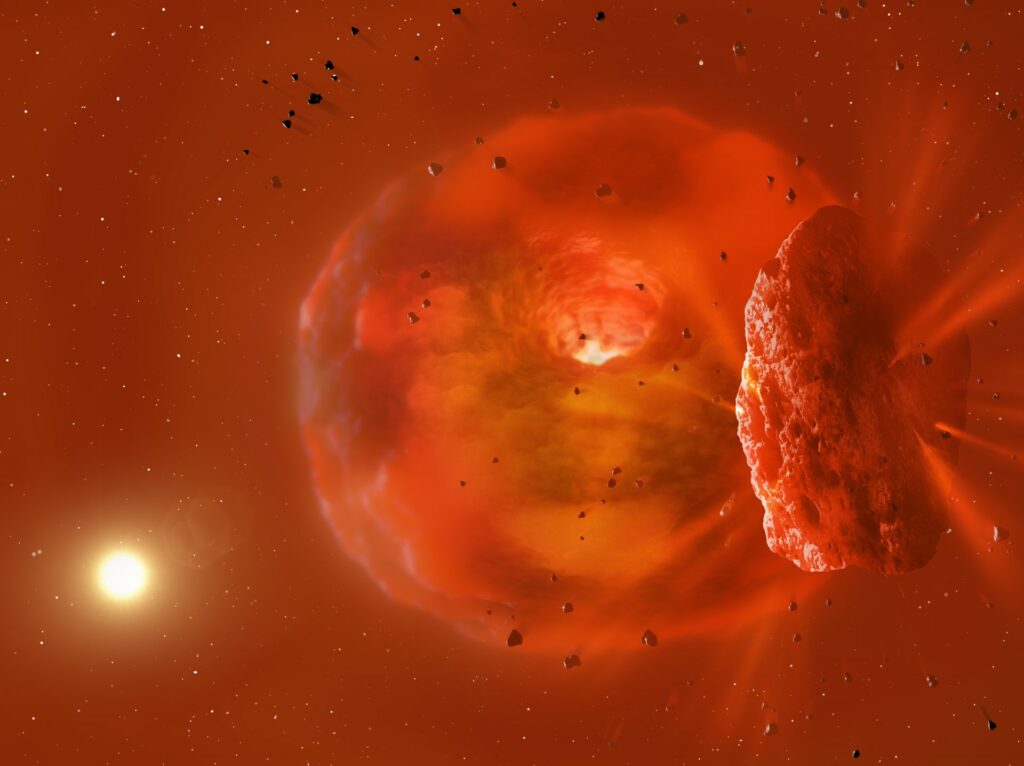In the infinite expanse of the cosmos, events of immense magnitude unfold. Most of these events go unnoticed, but every once in a while, something truly astonishing happens, capturing the attention of both experts and laymen alike. Imagine two massive ice giants, similar to our Neptune or Uranus, colliding with such force that they create a blaze of light and plumes of dust. This isn’t a scene from a science fiction movie but a real astronomical event witnessed by an international team of astronomers.
The discovery was nothing short of serendipitous. It all began when an enthusiast noticed something unusual about a star’s light curve, which is a graph showing the star’s brightness over time. This oddity led to a collaborative investigation by experts around the world.
“To be honest, this observation was a complete surprise to me,” admits Dr. Matthew Kenworthy from Leiden University, one of the lead authors of the study, in a statement. “When we originally shared the visible light curve of this star with other astronomers, we started watching it with a network of other telescopes.”
Thanks to the keen eye of an astronomer on social media, it was revealed that the star had increased in brightness in infrared light more than a thousand days prior to its dimming in visible light. This was a clear indication that something out of the ordinary had taken place.
The star was subsequently named ASASSN-21qj, commemorating the telescope network that first detected its peculiar behavior. It’s similar to our Sun but much younger at around 300 million years old.
But that’s not all. Roughly two and a half years after this infrared glow was detected, the star experienced a peculiar dimming in visible light, lasting about 500 days. This suggests that a long trail of the wreckage from the collision was drifting in front of the star, blocking some of its light and casting a cosmic shadow.
What Caused This Cosmic Phenomenon?
Upon careful examination and analysis, the researchers surmised that the most likely cause for this phenomenon was the catastrophic collision of two ice giant exoplanets, which are planets that orbit stars outside our solar system.
These titanic collisions, thought to be similar to the event that formed our Moon, occur in young solar systems. As planets develop and grow within swirling clouds of dust and gas around young stars, they can sometimes smash into one another, especially after the gas in the surrounding environment dissipates.
The aftermath of their collision produced an infrared glow that was picked up by NASA’s NEOWISE mission, a space telescope primarily tasked with identifying asteroids and comets.
“Our calculations and computer models indicate the temperature and size of the glowing material, as well as the amount of time the glow has lasted, is consistent with the collision of two ice giant exoplanets,” explains Dr. Simon Lock from the University of Bristol, another lead author.
The debris from this dramatic impact created a cloud that later passed in front of the star, leading to the noticeable dimming of its light.

What’s Next?
The aftermath of this celestial event is expected to unveil more secrets. In the coming years, the dust cloud resulting from the collision will likely spread out along the orbit of the remnant. This dispersion will produce a scattering of light, which can be detected by telescopes both on Earth and in space, including NASA’s largest space telescope, the James Webb Space Telescope.
The intrigue doesn’t end there. Dr. Zoe Leinhardt, an Associate Professor of Astrophysics at the University of Bristol, hints at even more exciting possibilities: “It will be fascinating to observe further developments. Ultimately, the mass of material around the remnant may condense to form a retinue of moons that will orbit around this new planet.”
The universe continues to amaze us with its wonders, and this collision serves as a powerful reminder of the dynamism and beauty that exists in the cosmos. As we learn more, one can only wonder: What other mysteries await discovery out there in the vast expanse of space?
The findings are published in the journal Nature.











